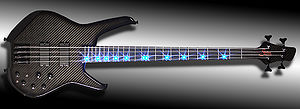Difference between revisions of "Chris' signature bass (?)"
m |
(got the doubleneck confused with chris' actual signature bass. derp) |
||
| Line 1: | Line 1: | ||
[[File: | [[File:CWcustom.jpg|thumb|right| [[Chris Wolstenholme]] Signature model]] | ||
{{Guitarbox | | {{Guitarbox | | ||
| Name = | | Name = Chris Wolstenholme signature Bass | ||
| Manufacturer = Status Graphite | | Manufacturer = Status Graphite | ||
| Used = | | Used = ? | ||
| Body = | | Body = One-piece graphite composite | ||
| Neck = | | Neck = Neck-through | ||
| BodyCovering = | | BodyCovering = High gloss lacquer | ||
| Wood = | | Wood = Carbon fiber constuction | ||
| Bridge = | | Bridge = Mono-rail bridge units | ||
| Electronics = Master volume | | Electronics = Master volume and pickup blend controls | ||
| Pickups = 2 Status | | Pickups = 2 Status hum-cancelling pickups | ||
| Special = | | Special = Treble and bass active E.Q. plus bright switch, control orientation reversed, midrange boost circuit. Both pickups have been shifted forward | ||
| type = | | type = bass guitar | ||
}} | }} | ||
From the Status Graphite website: | |||
''Chris originally bought his first headless Series 2 from a friend because he was so impressed with the tone. This first model was made in the early 80's. | |||
In the last few years he has used a wide selection of Status basses both live and in the studio. These include a couple of headed S2-Classics, a GP-Artist and a KingBass Mk-II. | |||
In the last few months we have developed a new Signature model which retains most of the classic Status features but has been tailored to Chris' personal playing style. | |||
1 : The bridge pickups has been moved away from the bridge by 20mm to make the right-hand technique a little more flexible. | |||
2 : The neck pickup has also been moved towards the fingerboard by 10mm which makes the tone a little warmer. | |||
3 : Volume / pickup balance and bass / treble controls have been reversed when compared to a standard Status bass. This has no effect on the way the controls operate, it's just a personal preference Chris has. | |||
4 : A new midrange control has been fitted : this has individual controls for both mid frequency and mid cut / boost. This allows you to pin-point the exact midrange frequency then adjust exactly how much is to be boosted or cut. This midrange control can be pre-set and there is an on/off switch to by-pass it completely. | |||
5 : Chris also specified front LEDs as a custom option. His main bass currently has blue LEDs but red, green, amber and white are also available. | |||
6 : Black hardware is standard on Chris' basses but gold and chrome are also available. | |||
7 : Individual mono-rail bridge units are fitted as standard.'' | |||
====Songs used for==== | ====Songs used for==== | ||
? | |||
{{ Backto | Bass}} | {{ Backto | Bass}} | ||
Revision as of 03:39, 15 September 2012

| Chris Wolstenholme signature Bass | |
|---|---|
| Manufacturer | Status Graphite |
| Used | ? |
| Body type | One-piece graphite composite |
| Neck joint | Neck-through |
| Body covering | High gloss lacquer |
| Wood | Carbon fiber constuction |
| Bridge | Mono-rail bridge units |
| Electronics | Master volume and pickup blend controls |
| Pickup(s) | 2 Status hum-cancelling pickups |
| Special circuits | Treble and bass active E.Q. plus bright switch, control orientation reversed, midrange boost circuit. Both pickups have been shifted forward |
From the Status Graphite website:
Chris originally bought his first headless Series 2 from a friend because he was so impressed with the tone. This first model was made in the early 80's.
In the last few years he has used a wide selection of Status basses both live and in the studio. These include a couple of headed S2-Classics, a GP-Artist and a KingBass Mk-II.
In the last few months we have developed a new Signature model which retains most of the classic Status features but has been tailored to Chris' personal playing style.
1 : The bridge pickups has been moved away from the bridge by 20mm to make the right-hand technique a little more flexible.
2 : The neck pickup has also been moved towards the fingerboard by 10mm which makes the tone a little warmer.
3 : Volume / pickup balance and bass / treble controls have been reversed when compared to a standard Status bass. This has no effect on the way the controls operate, it's just a personal preference Chris has.
4 : A new midrange control has been fitted : this has individual controls for both mid frequency and mid cut / boost. This allows you to pin-point the exact midrange frequency then adjust exactly how much is to be boosted or cut. This midrange control can be pre-set and there is an on/off switch to by-pass it completely.
5 : Chris also specified front LEDs as a custom option. His main bass currently has blue LEDs but red, green, amber and white are also available.
6 : Black hardware is standard on Chris' basses but gold and chrome are also available.
7 : Individual mono-rail bridge units are fitted as standard.
Songs used for
?